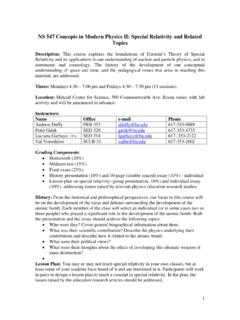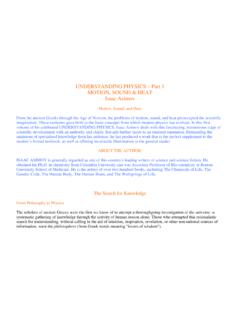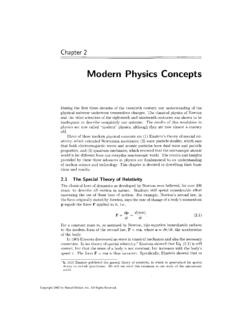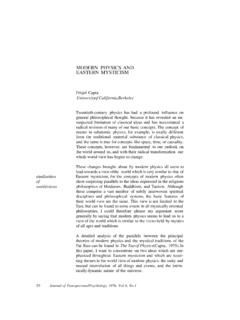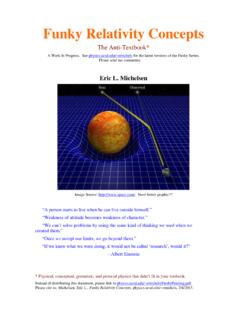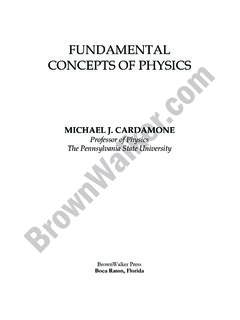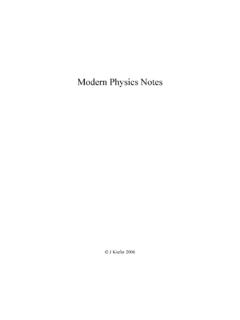Transcription of Concepts of modern theoretical physics - VU
1 MTF 2016 September 14, 20161 Concepts of modern theoretical physicsLectures:2 hours each week: 215, Thursday 1400to 1600and 2 hours for discussions: 815, Monday 900to 1100day Subject09/05 Overview, Introduction; assignements of seminars09/05 Special Relativity Repetition: Invariants, Lorentztransformations, Poincar e group [1, 2, 3]09/08 Special Relativity: Spinors [2, 3, 4]09/15 Quantum Field Theory: Approaches: canonical, path-integral [3, 5, 6, 7, 13]09/22 Quantum Field Theory: Feynman diagrams [2, 5, 6, 7, 8]09/29 no discussions, no lecture: (Visit in W urzburg)10/06 Quantum Field Theory: Renormalisation [5, 6, 7, 9]10/13 Quantum Field Theory: Gauge theory [3, 5, 6, 7, 10]10/20 Quantum Field Theory.
2 QED [5, 6, 7, 10]10/27 Quantum Field Theory: QCD [5, 6, 7, 10]11/03 The Standard Model: Particle content [2, 3, 11, 12]11/10 The Standard Model: Higgs Mechanism [2, 3, 11, 12]11/17 The Standard Model: Particle detection [2, 11]11/24 no discussions, no lecture: (Visit to Vienna)12/01 no discussions, no lecture: (Visit to Vienna)12/08 Outlook: Supersymmetry (SUSY) MSSM [5, 10, 14]12/15 Outlook: Strings, Stringtheory, Superstrings [15, 16]12/22 Questions, review of homeworkAttendanceoptional; will count towards the gradeHomeworksuggested; will count towards the grade; less credit for late homework;Grading:100 points = 100%,available points:30 attendance20 seminar presentation20 homework40 final exam: written and oral; 50% required to pass the and small letters are important!
3 Booksare availableMTF 2016 September 14, 20162 Reading assignmentsThe understanding of Special Relativity is needed for most parts of modern physics , although it might behidden, like in electro-magnetism. But it isessentialfor particle physics . Therefore Istronglyrecommendthe reading of the very short and very good introduction into Special Relativity by David Hogg [1]. In thelecture I want to stress additional features, which are not covered by David Hogg, but I will rely on thebasic understanding, as it is taught by David similar situation is with the presentation of Feynman diagrams.
4 There the reading of Griffiths [2]and Zee [5] is required. Of course, the questions resulting from the reading can be discussed in the weeklydiscussion presentationThe idea of the presentation is to involve the students into the discussion about particle physics and student chooses a subject for the presentation and clarifies with me, if the subject is suitable ornot. If it is suitable the student will get a time during the discussion hours to present the subject to thefellow students. The presentation can be given in English or in Lithuanian.
5 The presentation should berather short, about 5 minutes, and it has to be presented using the computer. The presentation has to be prepared in a computer readable format: . recommended, as the presentation will look the same, independent of thecomputer. a powerpoint presentation might work, too, but then it has to be done for Windows XP; The presentation should be given orally. It is recommended, that the student does not just read atext, but explains the subjects freely in his own words. The student should be able to answer questions from his fellow students.
6 That does not mean, thathe has to have all the presentation helps also practicing the necessary presentation of the masters thesis at the end of thestudents masters calculating some problems any lecture in theorectical physics remains a fairy tale. In that sensethe homework is required to profit from this lecture. The solving of problems helps to understand, whetherthe student has understood the material or not. At the exam it is too late to recognise, that one has notlearned the required students are invited to come before the homework is due to discuss the problems and ask.
7 I willgladly help them to understand the problem and guide them to the solution. The best way to arrange for ameeting is to write an email to arrange a time, as I can not guarantee that I will have always immediatelytime for the questions or that I will be always in my room (305).I plan to give less points for homework that is brought later than its due date. It will nevertheless helpto do the homework, even if it is late, as the exam will have questions and problems to solve similar tothe homework, exam will be a written test, that I want to discuss afterwards with the 2016 September 14, 20163 References[1] Lecture notes by David Hogg: [2] David Griffiths,Introduction to Elementary ParticlesJohn Wiley & Sons, Inc.
8 ; ISBN 0-471-60386-4 (1987)[3] M. Robinson,Symmetry and the standard model: Mathematics and particle physics , [4] P. B. Pal,Dirac, Majorana and Weyl [hep-ph].[5] A. Zee,Quantum Field Theory in a NutshellPrinceton University Press; ISBN 0-691-01019-6 (2003)[6] Michael E. Peskin and Daniel V. Schroeder,An Introduction to Quantum Field TheoryReading, USA: Addison-Wesley; ISBN 0-201-50397-2 (1995)[7] I. J. R. Aitchison and A. J. G. Hey,Gauge theories in particle physics : A practical 1: From relativistic quantum mechanics to QED,Bristol, UK: IOP (2003) 406 pVol.
9 2: Non-Abelian gauge theories: QCD and the electroweak theory,Bristol, UK: IOP (2004) 454 p[8] J. C. Romao and J. P. Silva,A resource for signs and Feynman diagrams of the Standard [hep-ph].[9] F. Olness and R. Scalise,Regularization, Renormalization, and Dimensional Analysis:Dimensional Regularization meets Freshman E & M,Am. J. (2011) 306 [ [hep-ph]].[10] Stefan Pokorsky,Gauge Field TheoriesCambridge University Press; ISBN 0-521-47816-2 (2000)[11] The particle adventure: [12] F. Jegerlehner,Renormalizing the standard model,Conf.
10 Proc. C900603(1990) 476.[13] Steven Weinberg,The Quantum Theory of Fields, I and IICambridge University Press; ISBN 0-521-58555-4 (1995)[14] Steven Weinberg,The Quantum Theory of Fields, IIIC ambridge University Press; ISBN 0-521-66000-9 (2000)[15] T. Mohaupt,Introduction to string theory,Lect. Notes (2003) 173; [hep-th/0207249].[16] W. Siegel,Fields,hep-th/9912205; ~ (2002)MTF 2016 September 14, 20164 Homework: Poincar e group due 2016/09/22, 14 Using the generator for Lorentz transformations (M ) = i( g g )(a) On what quantities do these generators act?



